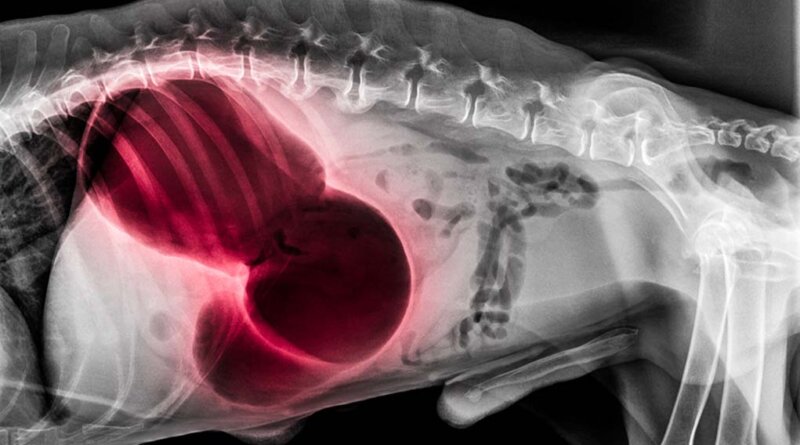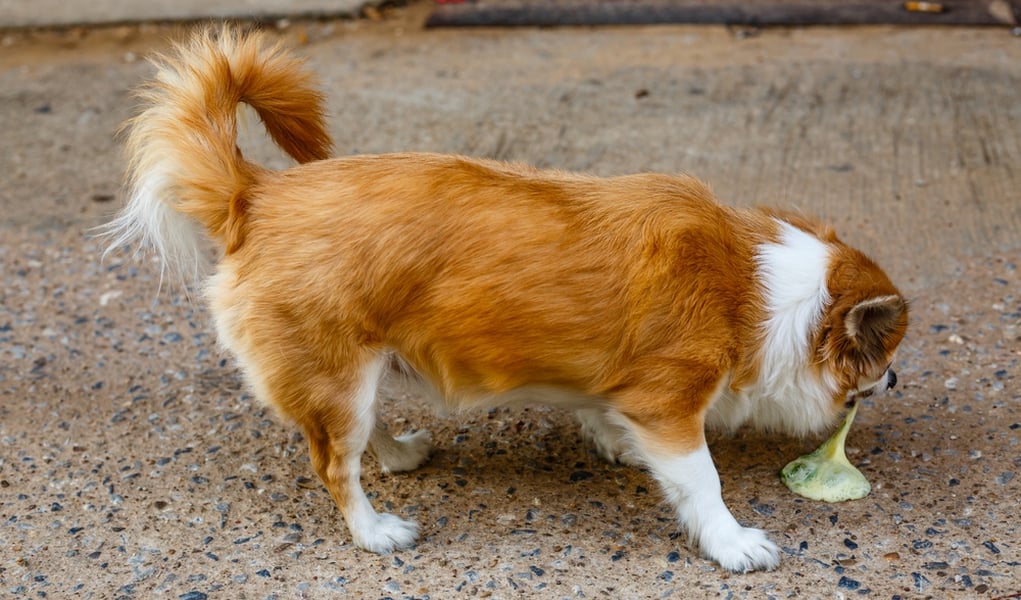11 Stomach Problems in Dogs with Pictures: Signs, Causes and Treatment
Gastrointestinal and stomach problems in dogs are common. They can be mild and barely noticeable or extremely serious and life-threatening. Most dog owners will have to deal with this, and a 2015 study showed that digestive issues are the most prevalent health problem in dogs.
Knowing how to recognize stomach problems in dogs can help you identify their severity and deal with them more efficiently. Spotting signs of dog stomach ache can prevent this from becoming a more serious condition, save time, money and even a dog’s life.
1. Vomiting
Although vomiting can often be a symptom of a more serious GI issue, it can also be caused by something fairly harmless. Most common causes of vomiting in dogs include overeating, eating something that the dog cannot digest properly, sudden diet changes, ingesting inedible things, and medications. Dogs may also vomit in a car as a result of motion sickness.
How to prevent it:
Preventing and addressing vomiting related stomach problems in dogs is as simple as investigating at potential causes. If you’re making changes to your dog’s diet, do that gradually (slowly changing food over 1-2 weeks).
Keep your dog away from inedible things, keep trash bins firmly closed and pay attention to what the dog puts in his mouth when you walk him. Make sure your pet doesn’t have free access to dog food (keep all pet foods in air-sealed containers) or table scraps. Do not give your dog any medications without consulting with a veterinarian first.
How to treat it:
Occasional vomiting in dogs is to be expected. Studies show that most cases are harmless and will pass quickly. But if vomiting repeats or won’t go away, it’s a sign of a serious stomach issue. Take the dog to see a vet to determine the cause. The vet might prescribe a mild medication or antibiotics in more severe cases.
When your dog vomits only on occasion but you see a pattern, consider a diet change (the dog might be allergic to some ingredients, or unable to digest them). Elimination diet may be needed. Feed your dog a bland diet of boiled rice and skinless chicken for 1-2 weeks, and ensure proper hydration.
2. Diarrhea
Like vomiting, occasional bout of diarrhea in dogs is common and can be caused by either benign things or a serious health issue. Diarrhea is most often associated with stomach upset in dogs and can be caused by your dog eating something indigestible, a foreign object, bacterial infections, allergies, medications and even stress.
Diarrhea can also be a symptom of something more severe, so when it happens on a regular basis, take your dog to the vet after the first few instances.
How to prevent it:
Similar to cases with vomiting, investigate potential causes. Prevent the dog any access to garbage or spoiled food. Keep him away from feces of other animals. Watch if your pet eats things while on the walk.
If you need to make changes to the dog’s diet to ensure firm stool, do so gradually. Try to keep your dog in a stress-free environment. Stay up to date on your dog’s vaccinations to prevent viruses which can lead to diarrhea.
How to treat it:
Hydration is particularly important when a dog has diarrhea. Provide clean water for your pet and encourage him to drink more (sometimes dogs refuse or forget). Chicken or bone broth are good to keep dogs hydrated and are more enticing for them.
Feed the dog boiled white chicken meat and rice, or try this homemade recipe. You can also switch to dog foods made for diarrhea which are going to be more gentle on a dog’s stomach. Take your pooch to the vet if diarrhea lasts more than a day.
3. Constipation
Constipation is the complete opposite of diarrhea – an inability for the dog to pass stools or passing dry and very hard stools. Some of the common reasons for constipation in dogs include lack of fiber in their diet, lack of exercise, enlarged prostate glands, medication side effect, dehydration and ingestion of inedible things.
How to prevent it:
Regular exercise is a good way to prevent constipation in dogs. If your pup is moving a lot through the day, his organs will be working at better efficiency to process, digest and release the food from the body.
Some owners inadvertently choose dog foods with little to no fiber, and do not supplement that diet with extra fiber, which is often the cause of constipation in a dog. Ensure your pet’s food contains approximately 4% fiber and encourage the dog to drink more water, especially in summer and after exercise. Using high fiber foods may prevent this but can also be the cause of constipation, so diet change needs to be discussed with a vet.
How to treat it:
Similar to humans, stomach problems in dogs that result in constipation can be treated using stool softeners and laxatives which are a quick short-term solution. You can also include digestive aids to help your pet process foods better.
Switching your dog to high(er) fiber dog food which contains about 10% fiber compared to 2-4% in regular foods may be recommended by your vet, as well as more water and exercise. Veterinary treatment may include medication in more serious cases to improve the contractile strength of the dog’s large intestine. In some instances, it is necessary to perform an enema (performed only by a veterinarian).
4. Viruses
Viruses like canine distemper or canine rotavirus (intestinal viral infection) can cause dog stomach problems. However, the most dangerous virus that affects dogs and often cause stomach ache and other digestive issues is canine parvovirus. Studies also show there’s a risk of co-infection of rotavirus and parvovirus.
Parvo in dogs most often affects unvaccinated puppies and adult dogs, and results in more health problems than just stomach issues. Parvovirus is transmitted by direct contact with either other infected dogs or their feces. The most common symptoms include vomiting, diarrhea, weight loss and lack of appetite.
How to prevent it:
Vaccination is the most effective way to prevent canine parvovirus and other viruses. But even vaccination does not guarantee complete protection from the disease.
On top of vaccines, maintain good hygiene and regular grooming schedule because parvovirus is resilient and can survive for more than a year on some surfaces. Use a bleach solution with water (1 part bleach, 30 parts water) to clean areas where your dog spends his time.
How to treat it:
Since canine parvovirus spreads quickly, a fast reaction is crucial. By the time you’ve noticed stomach problems in a dog, the disease has likely progressed so the dog must see a vet right away. In most cases of CPV, hospitalization will be necessary.
The treatment for parvo will consist of IV fluids and anti-nausea medications, supported by antibiotics to avoid any secondary infections. Keep your dog warm and away from other dogs until his infection is resolved.
5. Parasites
Intestinal parasites is a very common cause of stomach problems in dogs. These are most often presented in the form of worms like hookworms, whipworms, roundworms and tapeworms.
Other than worms, another parasite that attacks a dog’s GI tract is Giardia, which is a single-celled protozoan. Symptoms can vary depending on the type of parasite that is present, but some of the common signs are diarrhea, mucus in stools, vomiting and weight loss.
How to prevent it:
All dogs must be treated with dewormers. If you live in an area where parasites and worms are especially common, giving your dog preventive medicine is essential. If you do this, give it year-round and be consistent. Newest types of heartworm meds will prevent most other types of worms in dogs.
Keep your yard clean of any feces and don’t let your dog eat poop when you take him out on the walk. Don’t let your dog drink standing water since many parasites thrive in those conditions. Take your dog’s feces for an exam from time to time since some parasites can go unnoticed and without any symptoms.
How to treat it:
The treatment of internal parasites in dogs will depend on the type of parasite or worm. For example, roundworms and hookworms can be treated with products containing pyrantel pamoate. Make sure to deworm a dog regularly and take your pup to the vet to get the proper therapy after you notice serious symptoms.
6. Bacterial Infections
Different types of bacteria can attack the dog’s insides: E.coli, Salmonella, Helicobacter, and Campylobacter are most common. They often cause stomach problems in dogs with symptoms of diarrhea, vomiting, fever and lethargic behavior.
Bacterial infections in dogs are usually caused by contaminated water, feces, dairy or undercooked meat (typically from raw feeding). Bacterial infections are more common in dogs that spend time in shelters or spend a lot of time with other animals in the same area. Puppies and senior dogs have a higher chance of getting an infection since their immune systems are not as strong as that of adult dogs.
How to prevent it:
Prevention of canine bacterial infections is similar to that of viruses – avoid stagnant water sources, don’t let your pet eat feces and keep him away from trash, watch what he’s consuming when on your walks and whom he interacts with (unvaccinated stray dogs, for example).
Keep your dog’s water and food bowls clean, and feed the dog a well-balanced diet to ensure a strong immune system. Be particularly careful with dairy and raw meat. If switching to raw food diet, make sure you understand how to prevent bacterial infections.
How to treat it:
The usual therapy for bacterial infections and associated stomach problems involves antibiotics and dietary changes. However, you cannot do this by yourself and you need to take your pup to the vet to get the right treatment plan. It will differ depending on the type of bacteria and your dog’s current health condition, age and size.
7. Inflammation of the Large Intestine (Colitis)
Inflammation of the large intestine or colon in dogs (also known as colitis) can be caused by stress, bacterial or parasitic infections mentioned above, injury and trauma, and through ingestion of contaminated foods.
The primary symptom of dog’s stomach problems associated with colitis is diarrhea, and often bloody diarrhea. Straining to defecate and mucus in stools are also common signs, while vomiting occurs in 1/3 of the colitis cases in dogs.
How to prevent it:
The best prevention is to keep your dog away from common sources of bacteria and parasites, similar to the tips provided above. Again, prevent your dog from ingesting any foreign objects, contaminated foods and inedible things. Don’t make sudden changes to the dog’s diet and instead do it gradually.
How to treat it:
Colitis is treated by dealing with the underlying cause. However, there is also a non-specific treatment which includes the dog fasting for a day or two, feeding a hypoallergenic or low residue diet and increasing the amount of dietary fiber in a dog’s diet. If the cause is known, your vet will prescribe the appropriate treatment. You can also try a homemade diet alongside elimination trial – here’s a recipe to try.
8. Inflammatory Bowel Disease (and Syndrome)
Inflammatory bowel disease in dogs (IBD) is a name for a group of digestive system diseases that all have similar symptoms, causing a mountain of stomach problems in dogs, and lead to inflammation without a specific, known cause.
Inflammatory Bowel Syndrome in dogs (IBS) is a different but related condition, shares some similar symptoms and is often stress-induced. IBS in dogs is far less serious and more easily treatable than IBD, which is a broad term that displays many symptoms.
Signs of IBD in dogs include diarrhea, vomiting, weight loss and inflammation of the intestines. This is a hard condition to diagnose since the symptoms are common for many other stomach problems and don’t have a known cause, but one of the common ways of diagnosing IBD is a biopsy of the affected organ.
How to prevent it:
Since the causes of IBD in dogs will be unknown, there is no way to prevent the onset of the disease. Your best chance is to use all the above prevention tips for other stomach problems in dogs and hope for the best.
IBD is not too common in dogs (IBS is seen more often than IBD), so after you notice any dog stomach ache symptoms, it’s more likely to be a condition that’s not IBD.
How to treat it:
There is no way to cure IBD in dogs, according to research but it is possible to control it through diet changes and medications prescribed by a vet. Use the above mentioned treatment tips for other stomach issues and develop a management plan with your veterinarian. Adjust the diet and discuss stomach aid supplements with your vet.
9. Malabsorption
Malabsorption in dogs is a condition that leads to poor absorption of a specific nutrient or nutrients. This condition results from interference with absorption, digestion or both.
Interference with food digestion is usually caused by the lack of certain pancreatic enzymes (called exocrine pancreatic insufficiency), while absorption failure is mostly caused by the small intestinal disease in dogs.
Symptoms of malabsorption include long-term diarrhea, changes in a dog’s appetite and consistent weight loss. Sometimes, anemia, dehydration or fluid retention as well as other mentioned stomach issues can also be present.
How to prevent it:
There is no way to prevent malabsorption in a dog that would be caused by exocrine pancreatic insufficiency or small intestinal disease. However, since this condition can also be caused by viruses and bacterial infection, preventing these problems using the above mentioned tips may potentially prevent malabsorption as well.
How to treat it:
Treatment involves dealing with the cause directly but only in those cases where the actual cause can be identified; almost all treatment plans will include dietary changes. For example, there’s research on how canine malabsorption caused by exocrine pancreatic insufficiency usually requires giving your pup enzyme supplements, in addition to dietary changes like feeding the dog a low-fiber diet.
10. Bloat
While bloat in humans is often harmless, it can be fatal in dogs. Canine bloat, also known as Gastric Dilatation Volvulus, or GDV, is a condition that is not completely understood by scientists yet. However, it’s known to be a serious disease in which the dog’s stomach twists and fills with gas and can lead to death in a matter of hours.
Large breeds with deep chests are more susceptible to canine bloat but this condition can affect any breed and will result in stomach problems along with its own unique set of signs. Bloat symptoms include retching without vomit, a hard and swollen belly, drooling and other signs of distress in the dog.
How to prevent it:
Although the causes of Gastric Dilatation Volvulus in dogs are not understood yet, there are a few things that veterinarians recommended for preventing the condition, like sticking to low fat foods and feeding the dog smaller meals more often as opposed to one or two large meals throughout the day.
It is also recommended to avoid exercising the dog straight after a meal. Maintaining a healthy weight is also advisable since overweight and extremely underweight dogs are more prone to canine bloat.
How to treat it:
Take your dog to the vet as soon as you notice any of the bloat symptoms since time is of the essence. Treatment will usually involve the release of the built up gas and giving IV fluids. Once the dog is in a stable condition, a surgery is necessary to remove damaged tissue and prevent further attacks.
11. Gastrointestinal Ulcers
Gastrointestinal or stomach ulcers are lesions or sores that occur on the dog’s stomach lining, which serves as protection from gastric acid. Most common symptoms of stomach ulcers are weakness, decreased appetite and pain in the abdomen.
Chronic diarrhea and vomiting can also be present, and it can gradually transfer into symptoms related to the above mentioned stomach problems in dogs. There are many causes of GI ulcers in dogs including allergies, viral or bacterial infections, ingesting foreign objects, and stress.
How to prevent it:
Feeding your dog multiple times a day in small portions is a good way to relieve any GI irritation and possibly prevent ulcers. Some foods for GI problems will work better but you must discuss this with a veterinarian. Keep your dog away from stress since that can also contribute to gastrointestinal ulcers as well as IBS.
How to treat it:
Treatment of gastrointestinal ulcers will depend on the severity of this condition. For example, if ulcer has perforated the dog’s stomach wall, surgery might be necessary. IV fluids are often administered if signs of dehydration due to vomiting or diarrhea are present.
In less severe cases, anti-acid medication and dietary changes (low-fat and bland foods) are a common way to fight ulcers, in addition to finding and treating the underlying cause.
There are also a few natural remedies you can use like aloe vera, licorice root, alfalfa and slippery elm. You can switch to well-balanced homemade dog foods and try a recipe like this for sensitive stomach or a recipe for digestive disorders, both of which will be more gentle on a dog’s stomach and not agitate his ulcers.
In Summary
Stomach problems in dogs are very common, and almost every pet owner will have to deal with them at some point a pet’s life. Most of them are minor and usually are not a cause for concern.
It is best to take the dog to the vet if you notice symptoms of stomach issues that last longer, or that are more serious than occasional vomiting or diarrhea. A quick reaction and a proper diagnosis with a treatment plan will make a big difference.
READ NEXT: Veterinarian’s Guide on Buying and Using Dog Food for Sensitive Stomachs
















pharmacy canadian – mexico pharmacy order online reliable canadian online pharmacy
darknet drug market deep dark web
deep web drug url deep web drug markets
dark markets 2023 darknet markets 2023
Прекрасная фотосессия в студии – снимайте!
свадебная фотосессия в студии https://foto-sk.ru/.
A digital goods marketplace is an online stage that enables individuals or businesses to obtain, inform against, and clientele digital goods. Digital goods are intangible products that can be delivered electronically, such as software, music, e-books, photos, videos, online courses, and Top Affiliate Programs art.
Digital goods marketplaces can be designed looking for restricted characteristic of types of digital products, such as a tenets after selling stock photos, or they can be more inclusive, present a deviant multiplicity of digital products. Examples of digital goods marketplaces comprise Etsy for the purpose digital craftiness and wiliness items, Udemy on online courses, and Amazon allowing for regarding e-books and music.
Digital goods marketplaces provender a handy course in spite of sellers to reach a gigantic audience and in requital for buyers to identify a extensive breed of products in identical place. They typically provide tools exchange for sellers to record their products, manage inventory, and convert payments. Buyers can flick through and search seeking products, peruse reviews, and mutate purchases securely using a diversity of payment methods.
Story of the advantages of digital goods marketplaces is that they often offer a manner as a service to sellers to reap forbearing return via creating and selling digital products once, while buyers can fancy minute access to the products they procurement without having to minister to recompense shipping. Though, digital goods marketplaces also face challenges such as preventing piracy and ensuring the property of products sold on their platforms.
A digital goods marketplace is an online rostrum that enables individuals or businesses to buy, supply, and trade digital goods. Digital goods are ethereal products that can be delivered electronically, such as software, music, e-books, photos, videos, online courses, and [b][url=https://wmlogs.com]Top Affiliate Programs[/url][/b] art.
Digital goods marketplaces can be designed looking for indicated types of digital products, such as a tenets after selling offer photos, or they can be more customary, present a widespread off the mark multiplicity of digital products. Examples of digital goods marketplaces cover Etsy for the purpose digital aptitude and wiliness items, Udemy on online courses, and Amazon allowing for regarding e-books and music.
Digital goods marketplaces give a at one’s fingertips way in the course of sellers to reach a gigantic audience and representing buyers to secure a extensive choice of products in one place. They typically afford tools exchange for sellers to list their products, manage inventory, and convert payments. Buyers can flick through and search for products, scan reviews, and make purchases securely using a number of payment methods.
Story of the advantages of digital goods marketplaces is that they instances put on the market a road in the service of sellers to right to phlegmatic gains via creating and selling digital products once, while buyers can get a kick critical access to the products they procurement without having to be put on ice recompense shipping. Nevertheless, digital goods marketplaces also dial challenges such as preventing piracy and ensuring the quality of products sold on their platforms.
order lipitor pills buy lipitor generic generic atorvastatin 80mg
lipitor usa buy lipitor medication buy atorvastatin 20mg pill
oral finasteride diflucan 200mg brand buy fluconazole medication
proscar 1mg cheap order finasteride 1mg generic fluconazole 100mg canada
buy ciprofloxacin pills – order myambutol generic clavulanate brand
buy generic baycip over the counter – keflex 125mg tablet buy clavulanate online
buy generic baycip over the counter – bactrim online order augmentin 625mg usa
order ciprofloxacin generic – cipro 1000mg uk amoxiclav online
buy generic ciprofloxacin for sale – chloromycetin price erythromycin online order
buy metronidazole for sale – purchase amoxicillin sale buy zithromax 250mg pills
order flagyl 200mg online – order generic cefaclor 250mg buy azithromycin 500mg sale
ciprofloxacin 500 mg ca – tinidazole 300mg pills generic erythromycin
stromectol 12mg – ciprofloxacin order online buy generic sumycin 250mg
valacyclovir 500mg drug – buy zovirax without a prescription buy zovirax 800mg online cheap
buy valacyclovir pill – purchase nemasole online order acyclovir 800mg pill
stromectol 12mg – cheap generic sumycin tetracycline 500mg over the counter
purchase ampicillin sale purchase amoxil online amoxil over the counter
buy flagyl online cheap – buy flagyl without a prescription zithromax 250mg cost
buy flagyl paypal – order azithromycin buy zithromax no prescription
buy ampicillin generic buy penicillin pills for sale buy generic amoxicillin over the counter
buy furosemide generic – furosemide drug where can i buy capoten
order furosemide 40mg pills – order generic prograf 1mg captopril uk
buy generic glycomet – buy generic lamivudine order lincomycin 500 mg generic
glucophage medication – buy duricef 500mg order lincomycin generic
where to buy cheap retrovir without a prescription – order biaxsig generic order allopurinol 100mg generic
order retrovir 300 mg pills – zyloprim 100mg sale
buy clozapine without prescription – order generic clozapine 100mg brand pepcid 40mg
buy clozaril no prescription – glimepiride 1mg pills famotidine medication
seroquel 100mg pill – purchase luvox sale oral eskalith
quetiapine 100mg cheap – zoloft 50mg ca buy generic eskalith
purchase clomipramine online – order tofranil 75mg doxepin 75mg pill
order clomipramine 50mg pill – buy paroxetine 10mg buy doxepin pills
order hydroxyzine for sale – prozac 40mg over the counter endep over the counter
order hydroxyzine 10mg pill – order escitalopram pills buy endep without prescription
buy augmentin 625mg without prescription – brand augmentin 375mg baycip order
augmentin 625mg brand – buy augmentin 375mg for sale buy baycip cheap
buy amoxil online cheap – buy amoxicillin generic ciprofloxacin 1000mg canada
cheap amoxicillin pills – buy keflex 250mg online cheap ciprofloxacin oral
brand azithromycin 250mg – buy tinidazole pill ciprofloxacin 500 mg ca
purchase cleocin online – purchase doxycycline generic cheap chloramphenicol pill
cleocin 300mg uk – suprax tablet buy chloromycetin tablets
buy generic azithromycin – order tindamax 500mg without prescription brand ciplox
ivermectin 3mg stromectol – order eryc 250mg generic purchase cefaclor pills
purchase stromectol online – ivermectin 6mg tablet buy cefaclor pills
albuterol 2mg tablet – seroflo generic order theophylline 400mg for sale
albuterol for sale online – buy fluticasone cheap buy theophylline pills
medrol 8mg without a doctor prescription – buy zyrtec pills for sale astelin 10ml price
methylprednisolone over the counter – buy loratadine for sale buy azelastine 10ml generic
buy desloratadine 5mg pill – where can i buy beclomethasone albuterol inhalator buy online
buy clarinex 5mg pills – buy beclamethasone nasal spray for sale ventolin 4mg tablet